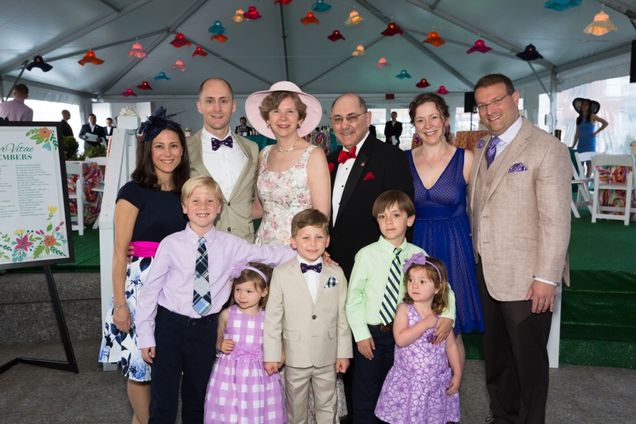Deans Need Progressive Responsibility Too
 Dr. Antman and her family at the 2016 American Heart Association Boston Heart & Stroke Gala.
Dr. Antman and her family at the 2016 American Heart Association Boston Heart & Stroke Gala.
Why aren’t more medical school deans women? Medical school faculty don’t normally wake up thinking, “I want to be dean.” How then does one end up there? I was asked to tell my story.
First, my parents didn’t burden me with the standard expectations for girls at the time. My father expected me to be able to change the tire on the car before I was allowed to drive. My mother worked full time and actually returned to school for a masters degree when I was in high school. Thus, I was probably less conflicted about working full time when our children were young than other women whose mothers had not worked outside the home.
During a college study abroad program in Czechoslovakia during the Prague Spring of 1967, I studied politics and economics, contrasting capitalism and communism, and explored Hungary, Romania, and Yugoslavia where half of physicians were women. Clearly women were not fundamentally unsuited for medicine. Also Czech students knew more about American literature and theater than I did. After returning to the US, I took more music, arts, and literature courses, which contributed substantially to a broader education. Playing college basketball taught me not only teamwork but more importantly that losing is not the end of the world. Risks are OK. In my senior year, I was elected the first woman student council president of the college, which had only recently begun accepting women. I learned that politics matter.
I arrived at Columbia College of Physicians and Surgeons in 1970, in a freshman class of 160 students, 16 of whom were women. I met Elliott Antman, a classmate and my husband-to-be, in the lobby of the medical student residence the day before we started classes.
Columbia provided me a great medical education. In a large urban tertiary care hospital, I learned the importance of hands-on clinical experiences and responsibility. Medical students were expected to bring journal articles to rounds and present cases concisely without notes—a priceless skill. I also was introduced to the expectation of “moving the field.” Learning current medicine and being the best possible clinician weren’t enough. We also needed to address gaps in medical knowledge. To this end, many students spent significant elective time doing research, as I did.
Our daughter was born just before Elliott and I moved to Boston to start our fellowships in cardiology at Brigham and Women’s Hospital and oncology at Dana Farber Cancer Institute (DFCI), respectively.
During my fellowship, again the expectation was to move the field. Elliott and I now had two children, and three years of laboratory research provided a break from night and weekend call. I was worried about our kids though, until our son wrote in an essay for his English class that “My mom develops cures for cancer patients.”
I had no plans to be an academic but I did have skilled and, probably more importantly, patient mentors who taught me manuscript and grant writing. Junior faculty at DFCI were hired then as instructors with no office, tech, or secretary. The chair of Biostatistics gave me a cubby in the biostatistics space (and schooled me in biostatistical methods). As an assistant to the chair of a large cooperative cancer research group, I met the best cancer clinical investigators nationwide and learned to design effective clinical trials. I also developed my own research programs; experience on NIH study sections honed these skills. Eventually I organized multiphysician teams with research nurses and administrators with laboratory and clinical collaborations in sarcomas, mesotheliomas, and marrow transplantation research. Each team member was a first author on her or his own project and somewhere in the middle of the author list on other projects, leading to promotions for all.
I asked senior leadership how often I should accept invitations for talks and was advised that I “needed a national and international reputation to get promoted” so I should do it until I “couldn’t stand it anymore.” So Elliott and I took the kids to medical and research meetings in Europe, Japan, and China. Both children have subsequently become physicians and married medical school classmates.
Active roles on professional association committees led to expertise in medical and research policy and more management experience, with opportunities to testify before congressional appropriations committees. After service on these boards, I became the president or chair of several societies.
Being able to move was key to accepting new positions. A stint as deputy director for translational science at the National Cancer Institute gave me a close up view not only of the NIH’s grants process but also of their equally important power to convene university and industry researchers to launch new initiatives and develop policy.
When I became dean, an experienced dean emphasized the importance of being, and appearing to be, fair. Faculty will generally accept some decisions they don’t like if leadership listened to their points of view and decisions were fair. From the management school faculty, I learned that execution is as important as vision, maybe more so.
Along the way, was I discriminated against as a woman? Yes, I could tell you some pretty remarkable examples, best handled with clear disbelief and humor. But I also was protected by other leaders who provided opportunities for women to succeed.
Over my career, I had progressive administrative responsibility, sequentially managing larger teams with bigger budgets. (Skipping a step in this progressive process results in critical gaps in management experience.) Given that selection committees for chairs and deans highly value academic excellence and prior supervisory and management experience, women who aspire to leadership positions should be looking for such opportunities.
Note: Dean Antman is chair, AAMC Council of Deans.
View all posts